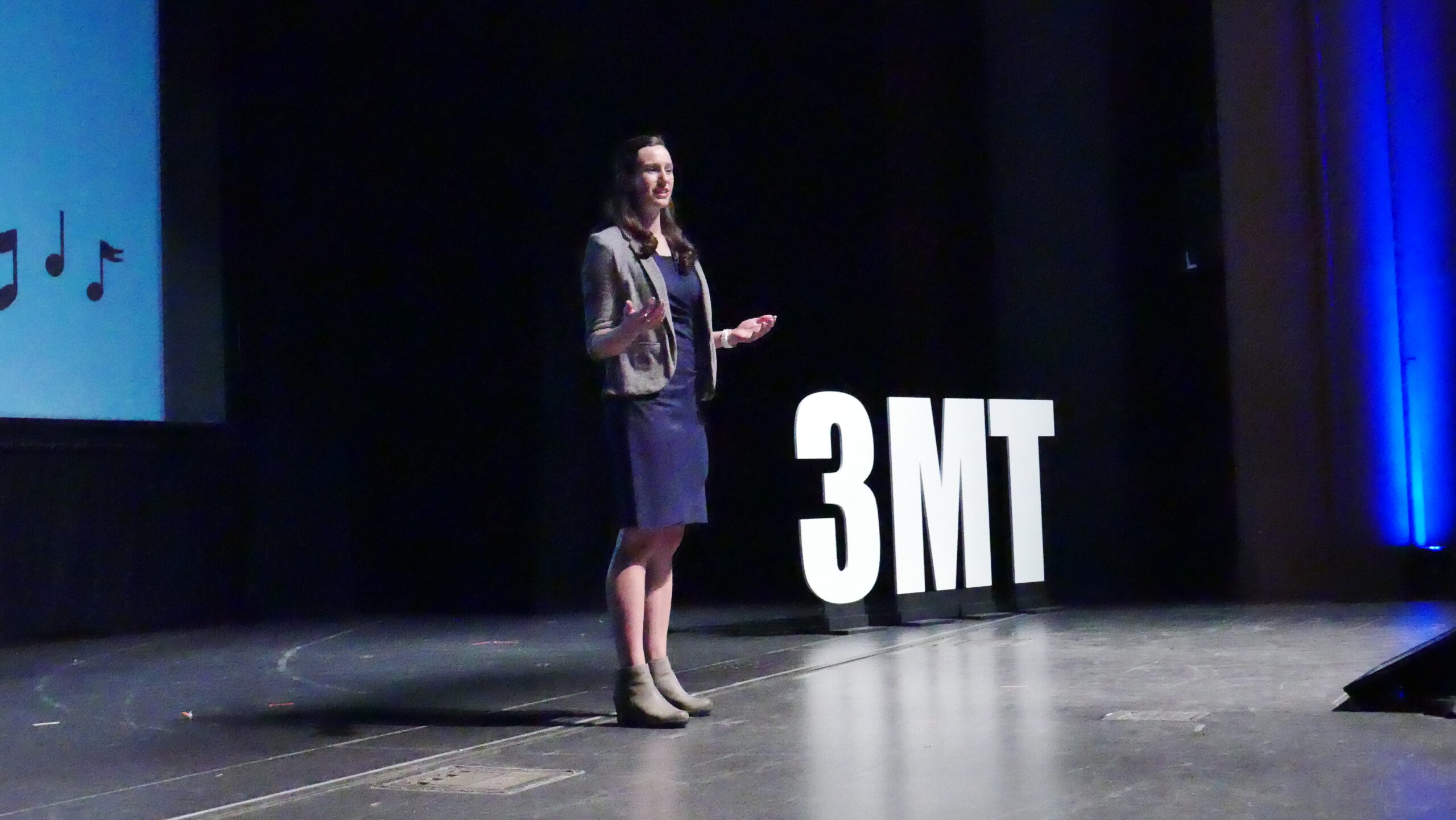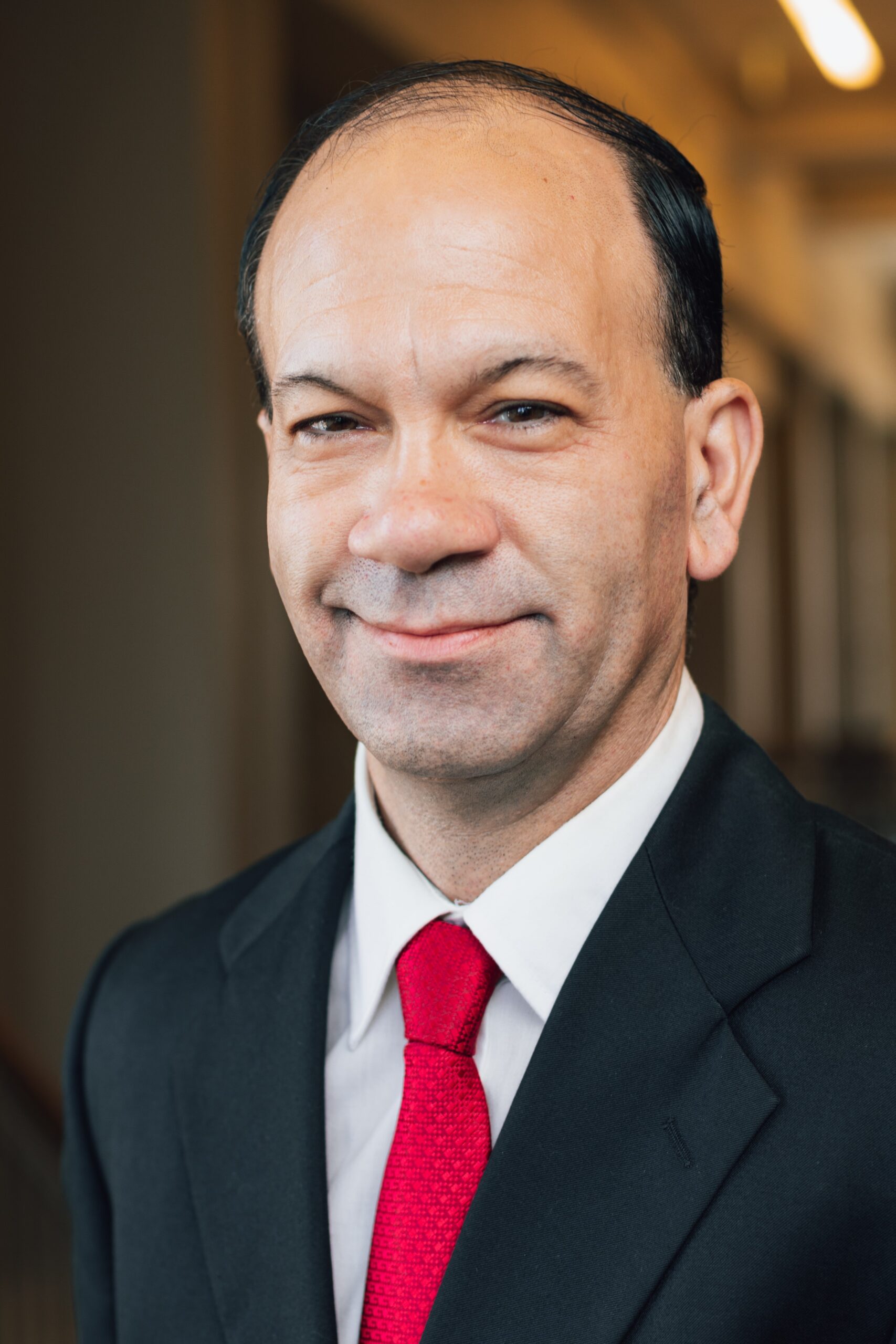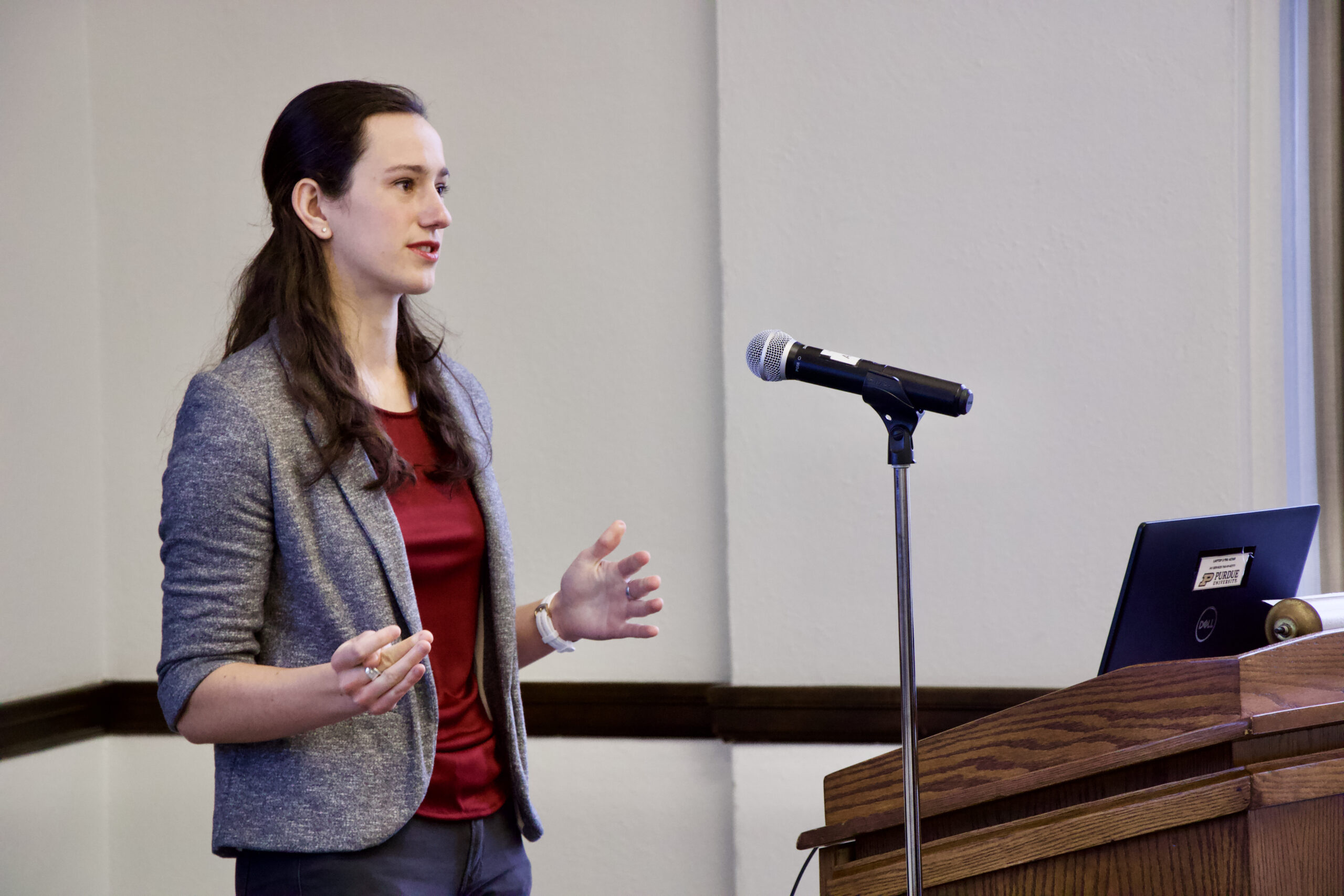Purdue graduate student investigates best hearing aids for listening to music

Emily Sandgen presents at the 2023 Purdue University Three Minute Thesis competition in April. Sandgren, along with her mentor Associate Professor Joshua Alexander, will publish findings on why some hearing aids are better for listening to music than others. The work will be found in Audiology Today this summer.
Written by: Tim Brouk, tbrouk@purdue.edu
Hearing “trouble … trouble … trouble” may be in store for Swifties and other concert-goers around the globe. According to the World Health Organization, nearly 2.5 billion people ─ or 1 in 4 ─ will be living with some degree of hearing loss by 2050.
Among the thousands of Taylor Swift fans basking in the mega pop star’s sonic glory on her current tour, a large number of them could need hearing assistance in the future. This would mean investing in hearing aids.
Luckily, hearing aids have improved in quality in the digital age. Conversations can be picked up better than ever. However, Emily Sandgren, a clinical Doctor of Audiology candidate in the Purdue University Department of Speech, Language, and Hearing Sciences (SLHS), and SLHS Associate Professor Joshua Alexander found most current hearing aids do not give tunes like Swift’s “I Knew You Were Trouble” and “Shake It Off” their justice.
“Speech and music acoustically are really different,” said Sandgren, a Naperville, Illinois, native who started her audiology externship at the University of Wisconsin’s University Hospital this month. “Many of the signal processing algorithms that make speech sound better and clearer will detract from music, where we have a wider range of frequencies, a bigger dynamic range and it’s just louder in general. Since music is louder than speech, it can saturate the input of the hearing aid and affect the sound quality no matter what the signal processing algorithms are doing.”
Sandgren and Alexander recently presented initial results on hearing aid quality and music for AudiologyOnline and have another article from the work to be published in Audiology Today later this summer. After recording audio clips of different styles of music — Latin, classical, rock and more — as processed through seven different hearing aids on the market, Sandgren collected data from 70 subjects with normal hearing who listened to the hearing aid recordings through headphones. Each hearing aid was tested in both the recommended settings for speech as well as recommended settings for music listening. A subject’s music quality ratings were used for quantitative data analysis and were supplemented by questions for qualitative details. The data was collected from August 2022-April 2023.
The results: Most hearing aids did not process the music adequately to the healthy Boilermaker ears. However, two were deemed better at processing music than the others. Alexander hypothesizes that one reason for the differences is how the microphones handle the low-frequency music components.
“My biggest takeaway from this study is the quality of the physical components that reduce saturation. They keep the signal within the range of what can be processed by the analog-to- digital converter. It prevents the signal from being distorted before it even reaches the digital signal processing,” she explained. “The two manufacturers stood out with the highest ratings because they’re using a microphone that helps address that problem.
“If we can draw attention to the fact that the physical components are making a difference in addition to signal processing algorithms, then that will increase the number of manufacturers using different microphones. Then, once we’ve made that step toward improvement, then we can continue looking at what will help beyond that.”
From marching bands to audiology labs
Sandgren grew up in a musical household. She first learned piano and cello as her primary instruments as a child, followed by percussion instruments, mellophone and trumpet later in high school and college, and she performed in orchestras and many other ensembles throughout school. During undergraduate studies at Samford University in Alabama, Sandgren played snare and bass drum in the pep and marching bands, always wearing ear protection, of course.
On the academic side, Sandgren was first interested in speech-language pathology but soon gravitated to its sister field of audiology.
“I just love that it combines the healthcare aspect of working with patients but also all of the STEM aspects of the technology with diagnostic equipment; the science of the physics and acoustics; and the biology, anatomy and physiology of the ear,” she said.
Surprising results

Joshua Alexander
When Sandgren pitched the idea of the music and hearing aids research project, Alexander was admittedly skeptical that any significant results would be found. He said improvements in modern hearing aids come in small increments from generation to generation, with new products hitting the market every year or two.
“I really thought we were going to be at ceiling performance,” Alexander stated, “and I started listening to these recordings: ‘Wow, there’s a lot more variation than I thought.’ I was personally surprised how bad some of them sounded. These are $3,000 hearing aids and can’t handle the music well. They sound bad, some of them. I was surprised there was that much degradation.”
However, recent industry trends have some manufacturers looking to differentiate themselves from the competition. Alexander cited Swiss hearing aid manufacturer Sonova’s purchase of Sennheiser, which is known for its microphones and headphones, for $241 million in 2021 as a sign that hearing aid users want more than just clearer speech from their hearing aids.
Another sign more hearing aid manufacturers are thinking musically is many companies employ acoustic engineers, many of whom are music aficionados, according to Alexander.
Then, there’s consumerism 101, of course.
“In a competitive market, they’re thinking ‘What else do people use their hearing for? What are some quality-of-life issues or ease of use that can make their overall experience better?’” Alexander said. “‘We’re going to design something to make music-listening better.’”
Wowing them in three minutes
Sandgren won the Purdue College of Health and Human Sciences Three Minute Thesis competition in April. Almost a year’s worth of work had to be explained in just three minutes, and like a concise, radio-friendly pop song, her message was music to the ears of judges. She also placed in the top 10 at the Purdue-wide Three Minute Thesis competition.
Just weeks later, the young researcher mingled with worldwide hearing experts at the annual Acoustical Society of America conference, which was held May 8-12 in Chicago. There, Sandgren gave a 15-minute presentation of the research and handled questions from industry leaders with aplomb.
“She just hit those questions right out of the ballpark,” Alexander recalled. “I was sitting next to a colleague that I’ve known for 20 years, and I go, ‘Man, she makes me so proud.’ She did a phenomenal job.”
Future clinician
While Alexander said his student could have a career in research and as a professor, Sandgren foresees a career as an audiologist at a hospital before opening her own private practice.
No matter what, Sandgren’s dual passions for music and helping people hear better will help shoot her to a platinum record of a career.
“I didn’t have dreams that were this big for the project, really,” she said. “I just wanted to know for myself and for my patients that I’ll see in the future. It’s been really exciting to share that with so many more audiologists and help get that information out there.
“Hearing aids are not perfect for anything, even for speech. They don’t restore normal hearing. They’re an assistive device, but they’re not a cure. Even (for) speech, they’ll never restore normal hearing. For music, they’ll never completely restore normal hearing, but the more we learn, the more we can make them the best they possibly can be.”

Sandgren won the Purdue College of Health and Human Sciences’ Three Minute Thesis competition.Tim Brouk